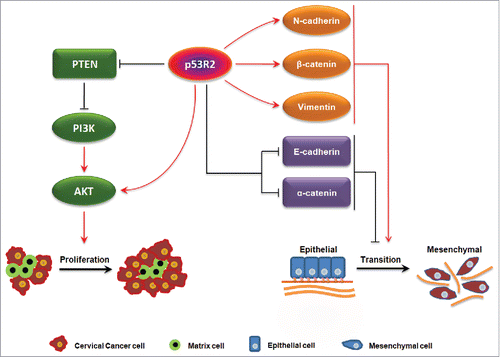Cervical cancer is a public health problem, representing the fourth most commonly diagnosed cancer in women and the seventh overall, with an estimated 527,600 new cases in 2012 across the world.Citation1 There were an estimated 265,7000 deaths from cervical cancer worldwide in 2012, accounting for 7.5% of all female cancer deaths and this number is expected to increase up to 410,000 by 2030.Citation2 For those advanced cervical cancer patients not amenable to curative treatments, such as surgery and radiation, palliative chemotherapy remain the standard of care. Although systemic treatment has entered into the era of targeted drugs, the antitumor efficacies of current therapies are still limited. Bevacizumab, the anti-VEGF (vascular endothelial growth factor) monoclonal antibody, is the only targeted drug approved by the FDA for the treatment of patients with metastatic, recurrent, or persistent cervical cancer, could improve overall survival from 13.3 months to 17 months.Citation3 In this context, there is a great need for identifying reliable biomarker and new therapeutic targets for cervical cancer.
Ribonucleotide reductase small subunit p53R2, also called RRM2B, is a p53-responsive factor involved in such functions as DNA replication and repair, cell cycle arrest, and mitochondrial homeostasis. With its critical role in deoxy ribonucleotide biosynthesis and DNA repair, dysregulation of p53R2 was suggested to be involved in tumor biology. Although expression level of p53R2 has been investigated in several human cancers, p53R2's roles in cancer progression and malignancy still remain controversial.Citation4 For instance, p53R2 has metastasis-suppressing potential in human colorectal cancer and liver cancer, but is also considered as a progressive biomarker in esophageal squamous cell carcinoma and oral cancer. Viable hypotheses have been proposed to explain the dual role of p53R2.Citation5 P53R2 inhibits cell proliferation and cell survival by inducing p21 and further cell cycle arrest. On the other hand, p53R2 repairs DNA and acts as scavenger of ROS, maintaining cell survival of both cancerous and non-cancerous cells, which causes cancer progression through exerting resistance to DNA damaging therapies such as clofarabine and radiotherapy.Citation6,7 Up to now, p53R2's biologic functions and the potential regulatory mechanisms in cervical cancer remain unknown.
Recently, Dr. X.F. Steven Zheng's group studied the function and mechanism of p53R2 in cervical cancer,Citation8 and found that p53R2 expression is significantly upregulated at both mRNA and protein levels in cervical cancer tissues and cells, and the overexpression of p53R2 was associated with increased risk of pelvic lymph node metastasis and cancer relapse. They further demonstrated that p53R2 is an independent factor for predicting overall survival and disease-free survival of cervical cancer patients, implying p53R2 may be a potential progressive/prognostic biomarker for cervical cancer. Through further investigation, they discovered the unconventional oncogenic functions of p53R2 in cervical cancer–involvement in malignant growth regulation (). They revealed that p53R2 promotes cervical cancer through at least two distinct mechanisms. First, p53R2 stimulates PI3K/AKT signaling as evidenced by the dependence of AKT phosphorylation and repression of PTEN expression on p53R2. Second, p53R2 enhances epithelial-mesenchymal transition, which provides a mechanistic explanation for increased metastasis in high p53R2 expressing cervical cancer patients. All these intriguing findings suggest that p53R2 is a potential therapeutic target for cervical cancer, which shed new light on p53R2's non-DNA repair function. Given the evidence that depletion of p53R2 using small molecules or siRNAs with high specificity could sensitize cancer therapy, it is reasonable to propose that inhibition of p53R2 may improve the efficiency of cervical cancer treatment.
Disclosure of potential conflicts of interest
No potential conflicts of interest were disclosed.
References
- Siegel R, Naishadham D, Jemal A. Cancer statistics, 2013. CA: a cancer journal for clinicians 2013; 63:11-30.
- Ferlay J, Soerjomataram I, Dikshit R, Eser S, Mathers C, Rebelo M, Parkin DM, Forman D, Bray F. Cancer incidence and mortality worldwide: Sources, methods and major patterns in GLOBOCAN 2012. Int J Cancer 2015; 136(5):E359–86; PMID:25220842; https://doi.org/10.1002/ijc.29210
- Boussios S, Seraj E, Zarkavelis G, Petrakis D, Kollas A, Kafantari A, Assi A, Tatsi K, Pavlidis N, Pentheroudakis G. Management of patients with recurrent/advanced cervical cancer beyond first line platinum regimens: Where do we stand? A literature review. Critical reviews in oncology/hematology 2016; 108:164-174; PMID:27931835; https://doi.org/10.1016/j.critrevonc.2016.11.006
- Kolberg M, Strand KR, Graff P, Andersson KK. Structure, function, and mechanism of ribonucleotide reductases. Biochim Biophys Acta 2004; 1699:1-34; PMID:15158709; https://doi.org/10.1016/S1570-9639(04)00054-8
- Cho EC, Yen Y. Novel regulators and molecular mechanisms of p53R2 and its disease relevance. Biochimie 2016; 123:81-4; PMID:26796884; https://doi.org/10.1016/j.biochi.2016.01.008
- Yousefi B, Samadi N, Ahmadi Y. Akt and p53R2, partners that dictate the progression and invasiveness of cancer. DNA Repair 2014; 22:24-9; PMID:25086499; https://doi.org/10.1016/j.dnarep.2014.07.001
- Yousefi B, Rahmati M, Ahmadi Y. The roles of p53R2 in cancer progression based on the new function of mutant p53 and cytoplasmic p21. Life Sci 2014; 99:14-7; PMID:24486301; https://doi.org/10.1016/j.lfs.2014.01.063
- Jiang C, Xu R, Li X, et al. p53R2 Overexpression in Cervical Cancer Promotes AKT Signaling and EMT, and Is Correlated with Tumor Progression, Metastasis and Poor Prognosis. Cell Cycle 2017; https://doi.org/10.1080/15384101.2017.1320629

